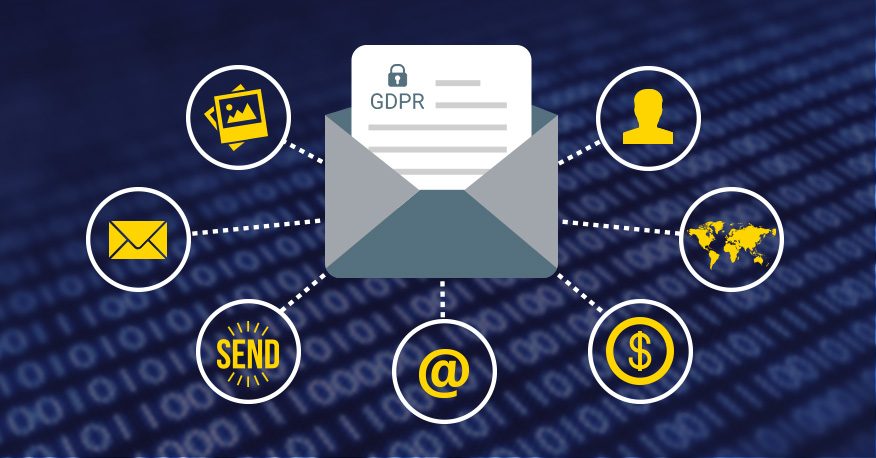The General Data Protection Regulation (GDPR) has transformed the landscape of data privacy and protection in the European Union (EU). Introduced in May 2018, GDPR not only impacts how organizations collect and process personal data but also significantly affects email marketing practices. For businesses that rely on email marketing as a core strategy for customer engagement and conversion, understanding GDPR’s implications is essential. This blog will explore the key elements of GDPR and its role in shaping email marketing strategies.

Table of Contents
Toggle1. Understanding GDPR
GDPR is a comprehensive data protection regulation designed to enhance individuals’ control and rights over their personal data. It applies to any organization that processes the personal data of EU residents, regardless of where the organization is based. Key principles of GDPR include:
- Consent: Personal data must be processed lawfully, fairly, and transparently, with explicit consent from the individual.
- Data Minimization: Organizations should only collect data that is necessary for their specific purposes.
- Right to Access and Erasure: Individuals have the right to access their data and request its deletion.
- Accountability: Organizations are responsible for demonstrating compliance with GDPR principles.
2. Impact of GDPR on Email Marketing
a. Consent Requirements
One of the most significant impacts of GDPR on email marketing is the requirement for explicit consent. Businesses must obtain clear, informed consent from individuals before sending marketing emails. This means that pre-checked boxes or vague agreements are no longer acceptable.
Action Steps:
- Revise Sign-Up Forms: Ensure that your email sign-up forms explicitly ask for consent. Include clear language about what subscribers are opting into.
- Document Consent: Keep detailed records of how and when consent was obtained for each subscriber.
b. Transparency and Clarity
GDPR mandates that organizations provide clear and transparent information about how personal data will be used. Email marketers must communicate their data processing practices to subscribers effectively.
Strategies for Transparency:
- Privacy Policy: Update your privacy policy to clearly outline how personal data will be collected, used, and stored. Make this policy easily accessible.
- Email Communication: Inform subscribers in your email communications about how their data will be used, including any third parties involved.
c. Data Subject Rights
Under GDPR, individuals have specific rights regarding their personal data. Email marketers must respect these rights and ensure that processes are in place to handle requests.
Key Rights to Consider:
- Right to Access: Subscribers can request a copy of their data. Be prepared to provide this information in a timely manner.
- Right to Erasure: Subscribers can request the deletion of their personal data. Ensure you have processes in place for honoring these requests.
3. Managing Opt-Out and Unsubscribe Processes
GDPR emphasizes the importance of allowing individuals to opt-out or unsubscribe from email marketing communications easily. Businesses must ensure that unsubscribe options are clear and straightforward.
Best Practices for Unsubscribe Management:
- Prominent Unsubscribe Links: Include an easily visible unsubscribe link in every email.
- Confirmation of Unsubscription: Send a confirmation email when a subscriber opts out, ensuring they have successfully been removed from your list.
4. Data Security and Protection
GDPR requires organizations to implement appropriate technical and organizational measures to protect personal data. Email marketers must ensure that data security is a priority to safeguard subscriber information.
Data Security Measures:
- Secure Data Storage: Use secure servers and encryption methods to protect subscriber data.
- Regular Audits: Conduct regular audits to assess compliance with GDPR and identify areas for improvement.
5. Email Marketing Best Practices Under GDPR
Adhering to GDPR not only ensures compliance but can also enhance your email marketing strategy. Here are some best practices to follow:
a. Build an Engaged List
Focus on building a list of engaged subscribers who have explicitly opted in to receive your emails. This improves open and click-through rates while ensuring compliance.
b. Segment Your Audience
Use segmentation to tailor your email campaigns based on subscriber preferences and behavior. This personalization can improve engagement and reduce unsubscribe rates.
c. Regularly Clean Your List
Periodically review your email list and remove inactive subscribers. This practice helps maintain an engaged audience and ensures compliance with GDPR requirements.
d. Create Valuable Content
Provide valuable content that resonates with your audience’s interests. When subscribers find your emails beneficial, they are more likely to remain engaged and responsive.
6. Conclusion
The GDPR has significantly influenced email marketing practices, placing a strong emphasis on consent, transparency, and data protection. By understanding and adhering to GDPR requirements, businesses can not only ensure compliance but also foster trust and build stronger relationships with their subscribers. Implementing best practices in email marketing under GDPR will lead to more engaged audiences, higher conversion rates, and long-term success in your marketing efforts. Embrace GDPR as an opportunity to enhance your email marketing strategy and prioritize the privacy of your customers!


No responses yet